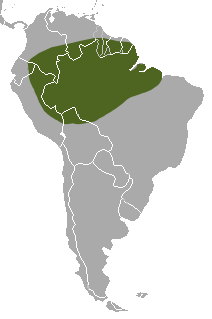Mustela africana
| Amazon weasel | |
|---|---|
| Scientific classification | |
| Kingdom: | Animalia |
| Phylum: | Chordata |
| Class: | Mammalia |
| Order: | Carnivora |
| Family: | Mustelidae |
| Subfamily: | Mustelinae |
| Genus: | Mustela |
| Species: | M. africana |
| Binomial name | |
|
Mustela africana Desmarest, 1818 |
|
 |
|
| Amazon weasel range | |
The Amazon weasel (Mustela africana), also known as the tropical weasel, is a species of weasel native to South America. It was first identified from a museum specimen mis-labelled as coming from Africa, hence the scientific name.
The largest of the three species of South American weasel, Amazon weasels measure 43 to 52 cm (17 to 20 in) in total length, including a tail 16 to 21 cm (6.3 to 8.3 in) long. They have a typical body form for weasels, with a long, slender, torso and short legs and ears. They have short fur which varies from reddish to dark brown on the upper body, and is pale orange-tan on the underparts. A stripe of fur the same colour as that on the upper body runs down the centre of the chest and throat. The whiskers are short and the soles of the feet almost hairless. Females have three pairs of teats.
Amazon weasels are known to inhabit the Amazon basin in northern Brazil and eastern Peru and Ecuador. However, the full extent of their range is unknown, and they probably also inhabit southern Colombia, Venezuela and the Guyanas, as well as northern Bolivia. The region is covered by tropical rainforest, and, while detailed habitat preferences are unknown, the weasel has mostly been recovered near rivers.
Two subspecies are recognised:
The Amazon weasel is rarely seen and little is known of its habits. They eat rodents and other small mammals, and have been reported to construct burrows in the stumps of hollow trees. They have been found from sea level to 1,250 m (4,100 ft), and have been reported to swim in rivers or estuaries, sometimes far from the shore.
...
Wikipedia

